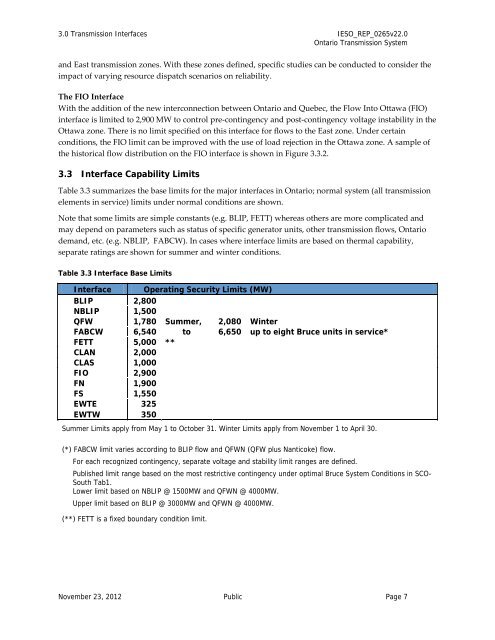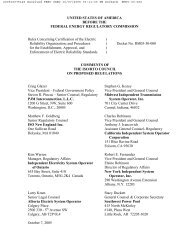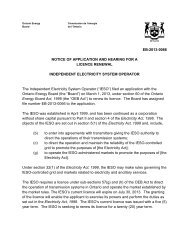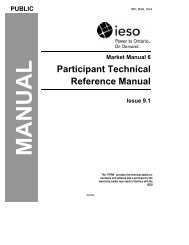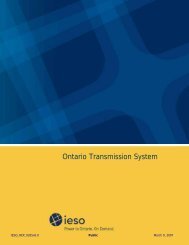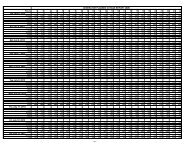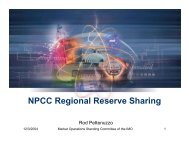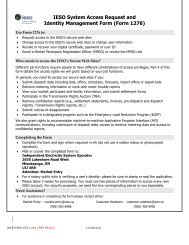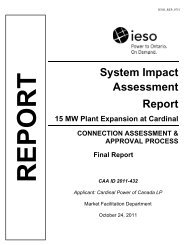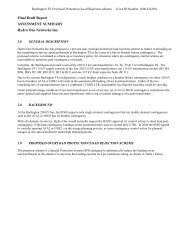Ontario Transmission System - November 2012 - IESO
Ontario Transmission System - November 2012 - IESO
Ontario Transmission System - November 2012 - IESO
Create successful ePaper yourself
Turn your PDF publications into a flip-book with our unique Google optimized e-Paper software.
3.0 <strong>Transmission</strong> Interfaces <strong>IESO</strong>_REP_0265v22.0<br />
<strong>Ontario</strong> <strong>Transmission</strong> <strong>System</strong><br />
and East transmission zones. With these zones defined, specific studies can be conducted to consider the<br />
impact of varying resource dispatch scenarios on reliability.<br />
The FIO Interface<br />
With the addition of the new interconnection between <strong>Ontario</strong> and Quebec, the Flow Into Ottawa (FIO)<br />
interface is limited to 2,900 MW to control pre-contingency and post-contingency voltage instability in the<br />
Ottawa zone. There is no limit specified on this interface for flows to the East zone. Under certain<br />
conditions, the FIO limit can be improved with the use of load rejection in the Ottawa zone. A sample of<br />
the historical flow distribution on the FIO interface is shown in Figure 3.3.2.<br />
3.3 Interface Capability Limits<br />
Table 3.3 summarizes the base limits for the major interfaces in <strong>Ontario</strong>; normal system (all transmission<br />
elements in service) limits under normal conditions are shown.<br />
Note that some limits are simple constants (e.g. BLIP, FETT) whereas others are more complicated and<br />
may depend on parameters such as status of specific generator units, other transmission flows, <strong>Ontario</strong><br />
demand, etc. (e.g. NBLIP, FABCW). In cases where interface limits are based on thermal capability,<br />
separate ratings are shown for summer and winter conditions.<br />
Table 3.3 Interface Base Limits<br />
Interface Operating Security Limits (MW)<br />
BLIP 2,800<br />
NBLIP 1,500<br />
QFW 1,780 Summer, 2,080 Winter<br />
FABCW 6,540 to 6,650 up to eight Bruce units in service*<br />
FETT 5,000 **<br />
CLAN 2,000<br />
CLAS 1,000<br />
FIO 2,900<br />
FN 1,900<br />
FS 1,550<br />
EWTE 325<br />
EWTW 350<br />
Summer Limits apply from May 1 to October 31. Winter Limits apply from <strong>November</strong> 1 to April 30.<br />
(*) FABCW limit varies according to BLIP flow and QFWN (QFW plus Nanticoke) flow.<br />
For each recognized contingency, separate voltage and stability limit ranges are defined.<br />
Published limit range based on the most restrictive contingency under optimal Bruce <strong>System</strong> Conditions in SCO-<br />
South Tab1.<br />
Lower limit based on NBLIP @ 1500MW and QFWN @ 4000MW.<br />
Upper limit based on BLIP @ 3000MW and QFWN @ 4000MW.<br />
(**) FETT is a fixed boundary condition limit.<br />
<strong>November</strong> 23, <strong>2012</strong> Public Page 7


